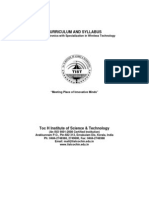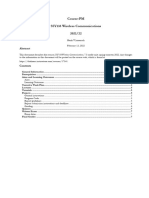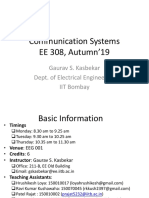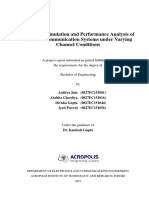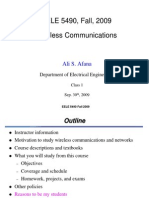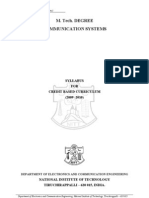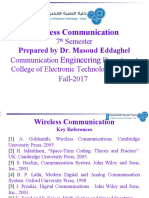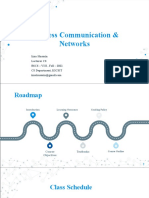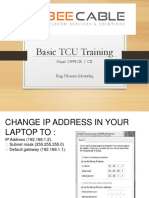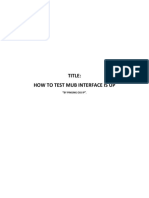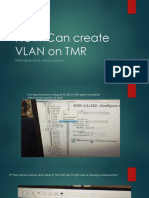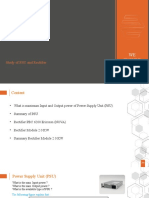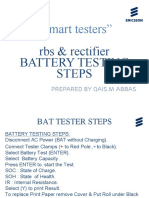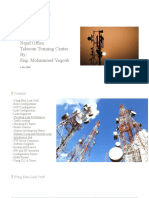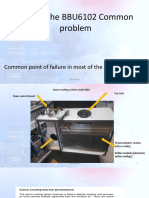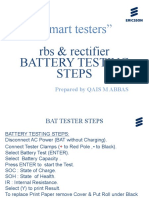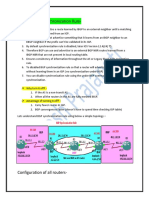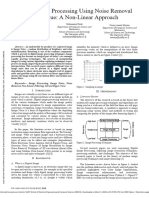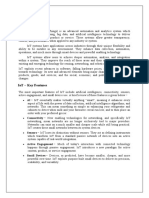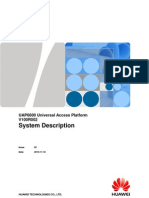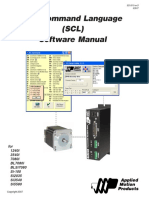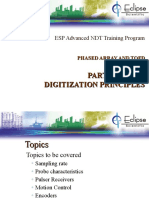University of Kufa
Faculty of Engineering
Electronics and Communications Department
im
Advanced Wireless Communications: Course Overview
lK
Assist. Prof. Dr. -Eng. Haider Al Kim
August 31, 2025
A
er
Overview
d
ai
The “Advanced Wireless Communications” course provides an in-depth understanding of
modern wireless systems, covering essential topics like antenna link budgets, multipath propagation,
H
and Rayleigh fading. Advanced techniques such as diversity, equalization, and convolution are
explored, along with modulation methods and systems like MIMO and OFDM, which are vital in
standards like 5G. In addition, channel codes, which improve communication reliability through
error correction, will be briefly covered, giving students a well-rounded view of advanced wireless
g.
communication technologies and their practical applications. The rest of this document outlines a
15-week curriculum for this course.
En
Contents
.-
1 Week 1: Preliminaries and Introduction for Wireless Communications 3
1.1 Complex Numbers and Phasors . . . . . . . . . . . . . . . . . . . . . . . . . . . . . . 3
Dr
1.2 Linear Algebra . . . . . . . . . . . . . . . . . . . . . . . . . . . . . . . . . . . . . . . 3
1.3 Probability Theory . . . . . . . . . . . . . . . . . . . . . . . . . . . . . . . . . . . . . 3
1.4 Fourier and Laplace Analysis . . . . . . . . . . . . . . . . . . . . . . . . . . . . . . . 3
1.5 Differential Equations . . . . . . . . . . . . . . . . . . . . . . . . . . . . . . . . . . . 3
1.6 Trigonometric Relations . . . . . . . . . . . . . . . . . . . . . . . . . . . . . . . . . . 3
f.
1.7 Overview of Wireless Communication System . . . . . . . . . . . . . . . . . . . . . . 4
o
1.8 Key Concepts in Wireless Communication . . . . . . . . . . . . . . . . . . . . . . . . 4
Pr
1.9 Challenges in Wireless Communication . . . . . . . . . . . . . . . . . . . . . . . . . . 4
1.10 Fundamental Techniques In Wireless Communication . . . . . . . . . . . . . . . . . . 4
2 Week 2: Antenna Theory and Propagation Models 4
2.1 Antenna Fundamentals . . . . . . . . . . . . . . . . . . . . . . . . . . . . . . . . . . . 4
t.
2.2 Signal Transmission . . . . . . . . . . . . . . . . . . . . . . . . . . . . . . . . . . . . 4
sis
2.3 Propagation Models . . . . . . . . . . . . . . . . . . . . . . . . . . . . . . . . . . . . 5
2.4 Practical Applications . . . . . . . . . . . . . . . . . . . . . . . . . . . . . . . . . . . 5
As
3 Week 3: Tutorial, Discussions and Quizz 5
1
� 4 Week 4: Multipath Propagation 5
4.1 Fading . . . . . . . . . . . . . . . . . . . . . . . . . . . . . . . . . . . . . . . . . . . . 5
4.2 Delay Spread . . . . . . . . . . . . . . . . . . . . . . . . . . . . . . . . . . . . . . . . 5
im
5 Weeks 5: Properties of Rayleigh Fading 5
6 Week 6: Capacity of Wireless Channels 5
lK
6.1 Shannon’s Capacity Theorem . . . . . . . . . . . . . . . . . . . . . . . . . . . . . . . 6
6.2 Capacity under Fading Channels . . . . . . . . . . . . . . . . . . . . . . . . . . . . . 6
A
7 Week 7: Exam 6
8 Week 8: Derivation of Selection Diversity Improvement 6
8.1 Selection and Frequency Diversity . . . . . . . . . . . . . . . . . . . . . . . . . . . . 6
er
8.2 MIMO and Spatial Diversity . . . . . . . . . . . . . . . . . . . . . . . . . . . . . . . 6
8.3 Mathematical Derivation . . . . . . . . . . . . . . . . . . . . . . . . . . . . . . . . . . 6
d
ai
9 Week 9: Tutorial, Discussions and Quizz 6
10 Week 10: Coding for Wireless Channels 6
H
10.1 Error Correction Coding . . . . . . . . . . . . . . . . . . . . . . . . . . . . . . . . . . 6
11 Week 11: Adaptive Modulation and Coding 7
g.
11.1 Dynamic Modulation and Coding . . . . . . . . . . . . . . . . . . . . . . . . . . . . . 7
En
12 Week 13: Digital Modulation and Detection 7
12.1 PSK, QAM, and FSK . . . . . . . . . . . . . . . . . . . . . . . . . . . . . . . . . . . 7
12.2 Detection Methods . . . . . . . . . . . . . . . . . . . . . . . . . . . . . . . . . . . . . 7
12.3 BER Analysis . . . . . . . . . . . . . . . . . . . . . . . . . . . . . . . . . . . . . . . . 7
.-
13 Week 12: Equalization 7
13.1 Linear Equalizers . . . . . . . . . . . . . . . . . . . . . . . . . . . . . . . . . . . . . . 7
Dr
13.2 Non-Linear Equalizers . . . . . . . . . . . . . . . . . . . . . . . . . . . . . . . . . . . 7
14 Week 14: Multicarrier Modulation and Spread Spectrum 8
14.1 Multiple Access Techniques . . . . . . . . . . . . . . . . . . . . . . . . . . . . . . . . 8
f.
14.2 OFDM . . . . . . . . . . . . . . . . . . . . . . . . . . . . . . . . . . . . . . . . . . . . 8
14.3 DSSS and FHSS . . . . . . . . . . . . . . . . . . . . . . . . . . . . . . . . . . . . . . 8
o
Pr
15 Week 15: Cellular Systems and Ad-Hoc Networks 8
15.1 Cellular Architecture . . . . . . . . . . . . . . . . . . . . . . . . . . . . . . . . . . . . 8
15.2 Ad-Hoc Networks . . . . . . . . . . . . . . . . . . . . . . . . . . . . . . . . . . . . . . 8
t.
sis
As
2
� 1 Week 1: Preliminaries and Introduction for Wireless Com-
munications
im
Foundational Mathematical Concepts
This week introduces the foundational mathematical concepts essential for wireless communica-
lK
tion systems. Topics include complex numbers, the complex plane, and phasors, along with vector
spaces, eigenvalues, and matrix decompositions from linear algebra. These concepts form the back-
bone for signal representation, channel modeling, and communication algorithms.
A
1.1 Complex Numbers and Phasors
er
In this part, you will study the complex plane that represents complex numbers, where the horizontal
axis is the real part, and the vertical axis is the imaginary part1 . Phasors allow us to represent
sinusoidal functions as complex exponentials, facilitating easier manipulation.
d
ai
1.2 Linear Algebra
H
This section teach the foundations of the linear algebra, focusing on the finite field, vector spaces,
matrices and their arithmetic operations. g.
1.3 Probability Theory
In this section, you will explore the concepts of probability and the likelihood, and differentiate
En
between them. Topics like random variables, probability distributions, expectations and more
details will be covered in this part.
.-
1.4 Fourier and Laplace Analysis
We will also refresh our knowledge about Fourier transformation, its inverse and the Laplace. This
Dr
leads us to recall convolution, linear time invariance system and other topics.
1.5 Differential Equations
In this part, you will briefly rehearse the basic concepts of the 1st - and 2nd - order linear differential
f.
equations.
o
Pr
1.6 Trigonometric Relations
Key trigonometric formulas are also covered in the Appendix part of this chapter.
1 The complex plane is essential for visualizing and manipulating complex numbers. It aids in understanding
t.
signal representations in wireless communication.
sis
As
3
� Introduction for Wireless Communication
1.7 Overview of Wireless Communication System
im
We explore here the evolution over time of wireless communications.
lK
1.8 Key Concepts in Wireless Communication
The student will overview the basic architecture of wireless systems, and review shortly the common
standards of wireless communication.
A
1.9 Challenges in Wireless Communication
Major challenges such as: fading and multipath propagation, interference and noise, as well as
er
mobility and changing the environment will be briefly mentioned at this point of the course.
d
1.10 Fundamental Techniques In Wireless Communication
ai
They are mainly the spread spectrum, orthogonal frequency division multiplexing (OFDM) and
multiple-input multiple-output (MIMO).
H
2 Week 2: Antenna Theory and Propagation Models
g.
This week explores the key aspects of antenna link budgets, which help predict the performance
En
of a wireless communication system. You will study path loss models, the free-space model, and
practical considerations that affect real-world wireless coverage. Path loss and shadowing are the
primary causes of signal degradation over distance and obstacles. The free-space model, log-distance
path loss model, and shadowing effects are discussed.
.-
2.1 Antenna Fundamentals
Dr
Definition of isotropic and omni-directional antennas.
Explanation of dipole antennas and their characteristics.
Introduction to isotropic radiated power and effective area of antennas.
o f.
2.2 Signal Transmission
Pr
Overview of transmit power (P t) and its significance.
Understanding power flux density and its calculation at the receiver side (Rx).
t.
Beamforming concept.
sis
As
4
� 2.3 Propagation Models
Introduction to free space propagation and its characteristics.
im
Explanation of path loss models, including free space path loss and Shadowing, and their
impact on signal strength.
Discussion on line of sight (LoS) vs. non-line of sight (NLoS) propagation scenarios.
lK
2.4 Practical Applications
Real-world implications of antenna design in cellular systems.
A
Understanding the importance of path loss in urban environments and its effect on signal
quality.
er
3 Week 3: Tutorial, Discussions and Quizz
d
ai
4 Week 4: Multipath Propagation
H
In this week, you will delve into multipath propagation, one of the main challenges in wireless
communication. Topics include the effects of multipath on signal fading and delay spread, which
are critical in system design and performance optimization.
g.
4.1 Fading
En
Multipath propagation leads to fading, where signal strength varies due to constructive and de-
structive interference.
.-
4.2 Delay Spread
Delay spread quantifies the spread in time of multipath signals, affecting the performance of wireless
Dr
systems.
5 Weeks 5: Properties of Rayleigh Fading
f.
This week focuses on Rayleigh fading, a statistical2 model used to describe the behavior of wire-
o
less signals in a multipath environment. Rayleigh and Rician fading models are introduced to
Pr
characterize the behavior of wireless channels under non-line-of-sight and line-of-sight conditions.
6 Week 6: Capacity of Wireless Channels
t.
The capacity of a wireless channel defines the maximum achievable data rate. Topics this week
include Shannon’s capacity theorem, its implications for wireless systems, and practical limitations
sis
like noise and interference.
2 Multipath propagation creates statistical variations in signal amplitude and phase. These variations are statistical
As
because the different paths randomly interfere with one another.
5
� 6.1 Shannon’s Capacity Theorem
Overview of Shannon’s theorem and its application to calculating the capacity of wireless channels.
We will also introduce the entropy concept that is directly related to the capacity theorem.
im
6.2 Capacity under Fading Channels
lK
Calculation of channel capacity under different fading conditions, including Rayleigh and Rician
fading.
A
7 Week 7: Exam
8 Week 8: Derivation of Selection Diversity Improvement
er
Diversity techniques are used to combat fading and improve signal reliability. This week, students
d
will explore selection diversity, frequency diversity, and spatial diversity (including MIMO systems)
ai
and how these techniques improve wireless communication performance.
H
8.1 Selection and Frequency Diversity
Explanation of how diversity in time, frequency, and space improves system performance by reducing
the effects of fading.
g.
8.2 MIMO and Spatial Diversity
En
Introduction to MIMO systems and how spatial diversity enhances communication through multiple
antennas.
.-
8.3 Mathematical Derivation
Dr
The improvement in performance can be derived mathematically by analyzing the probability dis-
tributions of the received signals.
9 Week 9: Tutorial, Discussions and Quizz
o f.
10 Week 10: Coding for Wireless Channels
Pr
This week provides a brief introduction to error correction coding in wireless communications.
Students will learn about convolutional codes, turbo codes, and LDPC codes, which are crucial for
improving communication reliability.
t.
10.1 Error Correction Coding
sis
Explanation of how coding schemes are used to detect and correct errors in wireless transmissions.
As
6
� 11 Week 11: Adaptive Modulation and Coding
Adaptive modulation and coding are techniques used to dynamically adjust transmission parameters
im
based on channel conditions. This week, students will study how systems can adapt modulation
schemes and coding rates in real-time to optimize performance.
lK
11.1 Dynamic Modulation and Coding
Overview of adaptive modulation and coding systems, including how they adjust based on channel
state information.
A
12 Week 13: Digital Modulation and Detection
er
This week introduces digital modulation techniques such as PSK, QAM, and FSK. Students will
learn how signals are modulated, transmitted, and detected at the receiver. Performance metrics
d
such as bit error rate (BER) are also discussed.
ai
12.1 PSK, QAM, and FSK
H
Introduction to phase shift keying (PSK), quadrature amplitude modulation (QAM), and frequency
shift keying (FSK) as common modulation schemes.
g.
12.2 Detection Methods
En
Overview of coherent and non-coherent detection techniques for digital modulated signals.
12.3 BER Analysis
.-
Computation of bit error rates for common modulation schemes under different channel models.
Dr
13 Week 12: Equalization
In this week, you will study equalization techniques, which are used to combat the distortions
introduced by the communication channel. You will explore both linear and non-linear equalizers,
f.
which are essential for improving signal reception in practical systems.
o
13.1 Linear Equalizers
Pr
Linear equalizers compensate for channel distortion by applying a filter to the received signal.
13.2 Non-Linear Equalizers
t.
Non-linear equalizers, such as decision feedback equalizers (DFE), provide better performance in
sis
certain scenarios.
As
7
� 14 Week 14: Multicarrier Modulation and Spread Spectrum
In this penultimate week, you will explore advanced topics that are crucial for modern wireless
im
communication systems. You will study MIMO systems and OFDM which are key components
in the latest wireless standards like LTE and 5G. Furthermore, Direct Sequence Spread Spectrum
(DSSS) and Frequency Hopping Spread Spectrum (FHSS), are discussed this week. Students will
lK
learn how these techniques increase system robustness and security in wireless communications.
14.1 Multiple Access Techniques
A
Introduction to TDMA, FDMA, CDMA, and OFDMA, including how they allow multiple users to
access the same channel.
er
14.2 OFDM
Multicarrier modulation, especially Orthogonal Frequency-Division Multiplexing (OFDM), is a key
d
technique in modern wireless standards such as LTE and 5G. This week covers the principles of
ai
multicarrier modulation and its application in wireless communication.
H
14.3 DSSS and FHSS
Overview of spread spectrum techniques and their application in secure and robust communication
systems.
g.
En
15 Week 15: Cellular Systems and Ad-Hoc Networks
The final week focuses on the design and operation of cellular systems, including infrastructure-
.-
based wireless networks and ad-hoc networks. Topics include cellular architecture, frequency reuse,
and routing protocols in ad-hoc networks.
Dr
15.1 Cellular Architecture
Overview of cellular system design, including frequency reuse, handoff mechanisms, and cell plan-
ning.
f.
15.2 Ad-Hoc Networks
o
Introduction to wireless ad-hoc networks and their routing protocols, highlighting their decentral-
Pr
ized nature.
Main Materials
t.
Molisch [1], Goldsmith [2] and Rappaport [3] are the main references used to create this course.
sis
As
8
� Related Sites
1. Third Generation Partnership Project: https://www.3gpp.org/
im
2. European Telecommunications Standards Institute: https://www.etsi.org/
3. International Telecommunication Union: https://www.itu.int/en/
lK
4. Global Mobile Suppliers Association: https://gsacom.com/
References
A
[1] A. F. Molisch, Wireless Communications. John Wiley & Sons, 2011.
er
[2] A. Goldsmith, Wireless Communications. Cambridge University Press, 2005.
d
[3] T. S. Rappaport, Wireless Communications: Principles and Practice, 2nd ed. Prentice Hall,
2002.
H ai
g.
En
.-
Dr
o f.
Pr
t.
sis
As
Mail: haider.alkim@uokufa.edu.iq
Phone: +9647817822030
Website: https://staff.uokufa.edu.iq/profile.html?haider.alkim
